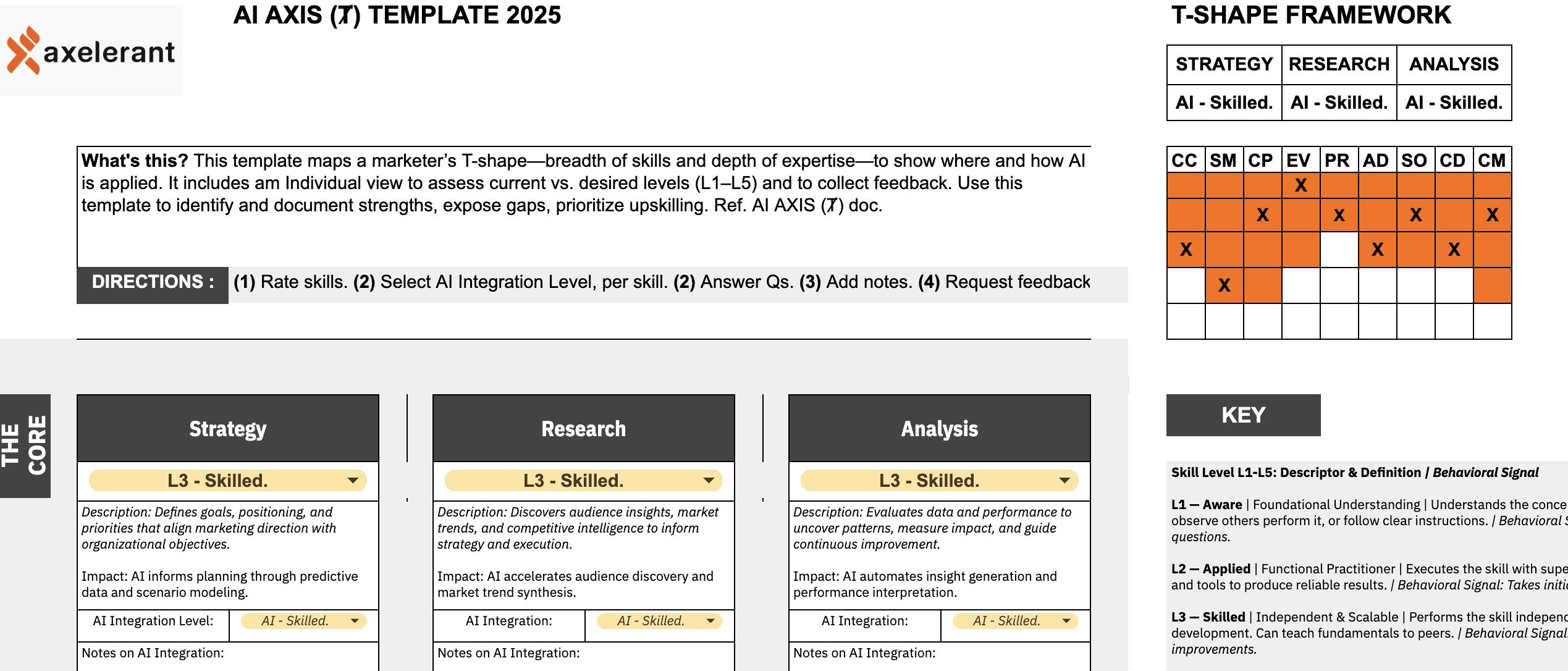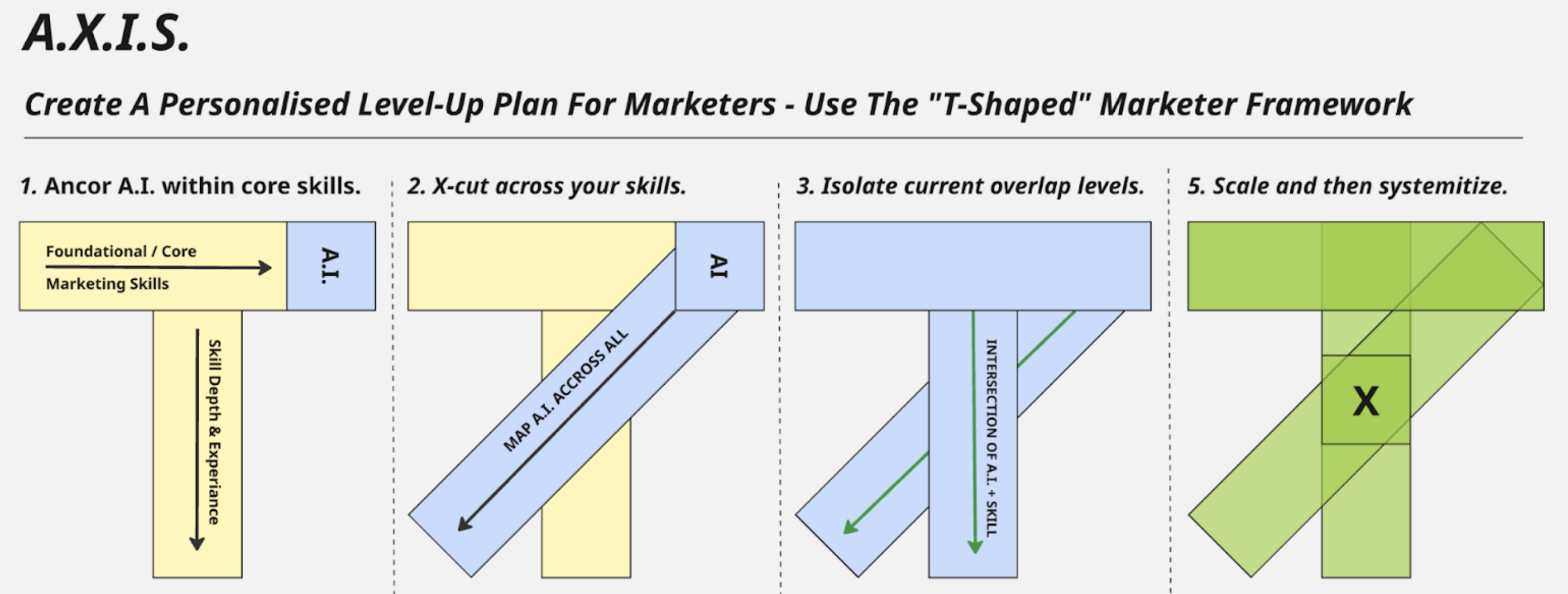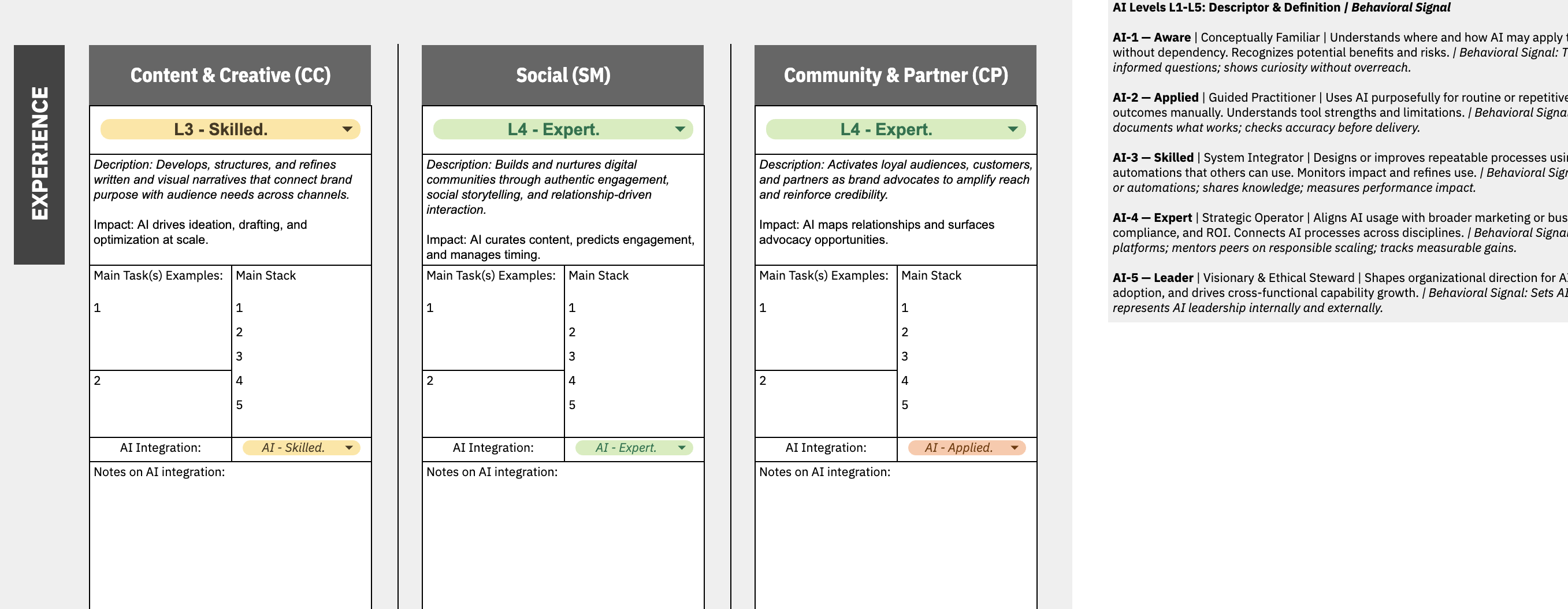What’s this? This outlines a strategic approach to applying the “AI Competency Framework” within marketing. The AXIS Exercise is a way to bring clarity to how marketers (or teams) adopt AI by building on the classic T-shaped framework. Traditionally, the T-shape shows a person’s breadth of skills across the top and their depth of expertise in one or more areas down the vertical.
AXIS introduces a slash (Ⱦ) across the T—a way to visualize and operationalize AI adoption across every skill. Instead of asking vaguely, “Have you adopted AI?” (which feels like boiling the ocean), the exercise helps you pinpoint where (which skills) AI is actually being used, at what level, and where gaps exist.
This framework adaptation is meant to help blow away the fog around AI adoption for marketers. It replaces broad, overwhelming directives (“apply AI everywhere”) with a step-by-step framework that makes adoption measurable, focused, and less intimidating.
—

The concept of the T-shaped professional dates back to the early 90s. First noted by management scholar David Guest in 1991, and reportedly used by McKinsey in the 1980s, the T-shape describes individuals with broad skills across disciplines (the horizontal stroke) and deep expertise in one area (the vertical stroke). IDEO’s Tim Brown popularized “T-shaped people” in the 1990s as ideal collaborators in design and innovation. The idea gained further traction in management theory when Harvard professors Morten T. Hansen and Bolko von Oetinger introduced “T-shaped managers” in 2001, emphasizing leaders who balance unit-level depth with cross-organizational collaboration.
Over time, the T-shape evolved from a metaphor for computing professionals into a widely adopted framework for describing adaptable, multidisciplinary talent in business, design, and marketing.
Back in 1991, UK-based management professional, now King’s College professor emeritus, David Guest first wrote his piece for The Independent entitled: “The hunt is on for the Renaissance Man of computing.” While only a fraction of the article (PDF) is publicly available, the piece outlines the need for multidisciplinary professionals; the concept later became known as T-shaped. Here are the basics:
The horizontal line represents the breadth of skills in a row.
The vertical line represents skill depth.
I’ve also read that McKinsey was internally using the term “T-shaped man” back in the 1980s to describe the kind of cross-functional consultants they needed to hire. I don’t have evidence of these McKinseyan origins, although the “T-shaped man” does feel very 80s ( 👔), am I right?
Regardless, the concept itself formed and was later popularized during the 90s in the U.S. by Tim Brown, the former CEO of the California design firm IDEO, who spoke frequently about “T-shaped people.” His words were re-hashed in a not-so-distant interview with Chief Executive:
“T-shaped people have two kinds of characteristics, hence the use of the letter “T” to describe them. The vertical stroke of the “T” is a depth of skill that allows them to contribute to the creative process… The horizontal stroke of the “T” is the disposition for collaboration across disciplines…T-shaped people have both depth and breadth in their skills.”
And Brown’s take on versatility was later given an organizational emphasis in 2001 in what would be a seminal article: “Introducing T-Shaped Managers: Knowledge Management’s Next Generation” by Harvard Business School professors Morten T. Hansen and Bolko von Oetinger:
“We call the approach T-shaped management. It relies on a new kind of executive, one who breaks out of the traditional corporate hierarchy to share knowledge freely across the organization (the horizontal part of the “T”) while remaining fiercely committed to individual business unit performance (the vertical part).”
So, from engineers to cross-functional consultants, and from multidisciplinary executives to interdepartmental managers who add value outside of their own vertices, the T-shape became a thing.
T-shaped marketers combine broad skills across many marketing channels (the horizontal stroke) with deep expertise in one or two areas (the vertical stroke). The idea was first applied to marketing in 2012 by SEO specialist Mike Tekula, who argued that depth must anchor breadth or marketers risk becoming “jacks of all trades, masters of none.” Rand Fishkin popularized the visualization in 2013 with “The T-Shaped Web Marketer,” and Brian Balfour expanded it into a structured career playbook for acquisition specialists, emphasizing collaboration plus channel mastery. In 2017, Buffer operationalized the model for hiring and team development, publishing real skill-maps of its marketing team.
Today, the T-shape remains the dominant framework for defining modern marketing careers, balancing versatility with specialization—even as new models emerge to address evolving challenges in the age of AI.
As the T-shape matured into a working framework that mapped skill depth and breadth for different kinds of professionals, it naturally found its way to be useful for marketers.
In 2012, then SEO pro Mike Tekula of Distilled—which is now Brainlabs—highlighted the framework as a diagram in an article only available via the Wayback Machine; he noted then that marketers, specifically SEO specialists at the time:
“[We must accept] that we can’t achieve mastery across a breadth of skill and knowledge sets, we need to specialize and cultivate deep knowledge in one discipline. Else we risk being generalists (people for whom those with deep expertise have a hard time building respect).”
This diagram was popularized across digital agency blogs at the time, as was the idea that the vertical line, the depth, should be supported by adjacent facilitators or supportive skillsets (e.g. like “Content” being the primary, buttressed by SEO and Social Media as secondary or tertiary).
Popularized likewise was the concern that a misapplication of the framework could foster a “jack of all trades, and master of none” problem. Again, the emphasis was placed on the necessity to have significant depth in a handful of skills, or to be a “jack of all trades, master of some.”
The next year, Rand Fishkin, the former CEO and founder of Moz, gave the model a widely shared visualization in a 2013 article (“The T-Shaped Web Marketer”), highlighting the horizontal breadth (video, community, blogging, etc.) with a consolidated depth vertical, mixing certain aspects of the horizontal.
And around the same time, Brian Balfour (then a VP of Growth at HubSpot) translated the idea into a concrete learning path in a deep dive on customer acquisition from a career standpoint: go broad enough to collaborate, then go deep, incrementally, in a few channels. This emphasis helped to transform the concept into a plan, or a templated career playbook. He included links to many free courses, lesson plans and recommended books to help marketers firm up the Base Layer, Marketing Foundation Layer, and Channel Expertise.
This brings us to the cornerstone initiative by Buffer in 2017: How to Become a T-Shaped Marketer: What Marketing Career Growth Looks Like – published by their former VP of Marketing, Kevan Lee. With this, Buffer operationalized the T for hiring and development with a diagram and real team examples, cementing it as a practical rubric for modern marketing teams. At the time Buffer had eight marketers; Kevan published the diagrams of each employee, their skills reflected in individualized t-shapes.
Buffer’s example became the modern reference point—and it still is. Since then, several different letters have been used to describe the marketing needs of the day, including: I-shaped, v-shaped, and m-shaped.
What began in 2012 as a sketch of constraints for SEOs matured into a shared language for entire marketing teams. The T-shape gave marketers a way to communicate about growth without losing sight of depth, and to design careers without becoming “jacks of all trades, masters of none.” This important balance—between breadth that builds bridges and depth that earns trust—remains a core challenge for marketers today.
Especially as AI disrupts, revolutionizes, and demands more.
AI is reshaping the T-shaped marketer framework by cutting across both breadth and depth of skills. Traditionally, the T-shape represented wide knowledge across disciplines (horizontal) with deep expertise in one area (vertical). Today, AI must be anchored as a core horizontal skill, intersecting every domain of marketing—from content and analytics to community and campaigns.
The AI AXIS (Ⱦ) Exercise is a practical method for mapping these intersections.
Most marketers say they use AI, but few of us can show exactly where it intersects across our skills, and fewer of us know what to do next. Many of us are overwhelmed with a sense of having to flood the zone with new tools, without losing sight of the bigger picture. Anxieties run high when pragmatic, strategic direction isn’t possible. Regardless, adoption and adaptation isn’t an option.
This transformation will reach far, and deep, touching every aspect of the role of the marketer—at every level. Far beyond utilizing the basic interface as a peer, with prompts aimed at generating or refining copywriting or brainstorming ideas, Marketers have to inculcate and integrate these solutions, systemically, into every skillset—with intention.
Wave upon wave of tool updates, launched solutions, AI integrations, and more—all churned up by the highs and lows of changing expectations—leaves all marketers in the same boat—and we’re all seasick.
We’re attempting to manage this org-wide. Recently at Axelerant, an org-wide rollout of an AI competency framework was announced. Every department head of the agency received a sheet that broadly sketched the needs, per role level. This was ours in Marketing:
The obvious challenge here is that the L1-5 highlights are an amalgamation, including everything from content creation to customer engagement, and from campaign personalization and segmentation to analyzing marketing metrics systematically.
While it’s true that AI touches everything in marketing, if we don’t discern and pinpoint the touchpoints—and apply these for each of us—we’re lost.
We need to be more specific and precise.
Without isolating specific overlaps between AI and a skill, we don’t have a clear view of our current state of growth, the gaps, or what to do next.
With the right exercise, the T-shaped marketing framework can help us.
How do we systemically adopt AI as Marketers? It’s one thing to know you’ve got to do something, like upskilling, but it is an altogether different thing to figure out how to do it and where to start.
I took the T-shaped marketing framework and drew a slash through it. That’s what AI has done—across every skill, at every level.
That’s when I recognized how useful it would be if I had an answer to the following question: “…how can I pinpoint where I’m at with AI adoption per skill; how do I isolate the gaps?”
I think the AI Axis (Ⱦ) Exercise could be way for marketers to blow away some of the fog of AI adoption. If the marketing role can be reflected in the T-shape marketing framework (again: horizontal for breadth, vertical for depth), and the vertical depth of skill can be given associated levels, then we can apply an AI line across the diagram. What you’re ultimately going to produce is a line graph that reflects AI touchpoints per skill level. This will expose the gaps in a clearer way, which is the first step in filling them.
The basic concept:

Isolate the current level of AI adoption per skill to spot gaps and to chart a direction.
The AI AXIS is a motion. It runs across, it finds touchpoints, and eventually it colors everything. Beginning with the drawing of the AI “line” across the T-shaped framework, and ending in the full-scale manifestation of AI transformation over everything.
The basic steps (A.X.I.S.) follow:
(A)nchor AI within core skills (horizontal).
By anchoring AI as its own core, you treat AI not as an add-on, but as part of your foundational breadth that will cut across everything else. Just as content, analytics, or social once earned their place on the horizontal line, AI now belongs there, too—embedded within the horizon.
(X)-cut across your skills.
Draw a line through your framework and reflect on how AI intersects with every discipline. New tools, integrations, and systems apply here. From content to community, consider how the AI line runs through it all and at every L-level.
(I)solate the overlap.
Go vertical now. In your primary columns of expertise, at what level of application or adoption do you find yourself? Within Axelerant marketing, L1-L5 across each skill vertical is categorized by:
If you’re at a Content L4, at what L-level is your AI line?* Your touchpoint or your AI line overlap is likely lower. Maybe you’re at a practical implementation of some tools, for example, but you’re not yet at L3 (able to drive and scale it).
*Note of caution: the exercise is meant to identify gaps and to help you conceptualize, pragmatically, at what level of AI adoption you’re at; this is meant to help you develop a plan to appropriately backfill and scale with AI in every skill. It will cause you to think, to ask questions like: how is AI being used here, at this level? And this is the first step to finding an answer and then applying it for your own growth, development, benchmarking, etc.
(S)cale and systemize.
You’ll see how AI is beginning to color everything—the campaigns you run, the workflows you design, the strategies you set. Saturation means AI isn’t a separate skill anymore; it becomes a new hue across the T. At this stage, you can see how these columns are connected by AI tools, techniques and systems that are reshaping marketing as a sector.
You can’t begin unless you have a Marketing T-shape. From there, you need to define your levels. After this, each team member needs to be mapped accordingly. From here, you can create a live template that can be referred to by all, showing the AI-meets-level touchpoints across every skill. So, in summary:
You need a T-Shape. The T is your foundation. Without a clear articulation of breadth and depth—what skills sit on your horizontal line, and what verticals represent true expertise—there’s no canvas for AI to intersect. Every marketer’s T looks different: one person may anchor in content, another in analytics, and another in community. Mapping these skills first ensures you can later see precisely where AI touches, enhances, or even disrupts them.
L-Levels must be defined. Levels bring structure and progression into the exercise. In marketing at Axelerant, we’ve framed them from L1 (understands the concept) to L5 (customer-facing SME capabilities). These levels describe not just familiarity with a tool, but maturity in the applied skill. Without levels, the AI touchpoints can’t be pinpointed.
Your people have to be mapped to it. Frameworks don’t create clarity until they’re personalized. Once you’ve defined the T and the levels, you have to apply it personally. Consider the Buffer example as a prerequisite for AXIS. You could have each team member map themselves and then have their managers map them accordingly. The truth will likely be the median between the two.
You need a live template that reflects all AI-meets-Level touchpoints. The exercise comes alive when there’s a visual template—a picture that shows every skill on the horizontal line, every depth vertical, each L-level, and the AI “line” intersecting them. This isn’t a static chart to file away; it’s a working reference that marketers and teams can return to as AI tools evolve. Done right, the live template becomes both a diagnostic (showing current overlaps) and the foundation for a playbook (pointing to where AI should be applied next).

The classic T-shaped framework has long helped professionals conceptualise and develop their own breadth and depth of skill—and today AI cuts across all of it. The AI AXIS (Ⱦ) Exercise offers an approach: a practical way to cut across skills, isolate touch points, and reveal where AI is actually being applied—and where it’s not. By anchoring AI in the horizontal, cutting across disciplines, and isolating overlaps intentionally, marketers (and perhaps others as well) can get help moving from anxiety and abstraction to clarity and intention.
What’s next for us?
We hope to apply AXIS in a way that brings clarity over confusion.
In the past we aspired to create a T-shape marketing framework for every marketer within Axelerant, complete with a points system that showcases per-kill L-level advancement. Initially conceived as a skillsmap template that could help us provide feedback, set the bars for promotion, etc. It was a layered numeric system that was too multivalent to be practical. Not all good ideas scale. Will this?
Can we rely on the “classic T” this new concept of AI AXIS to help us? Connect with me and I’ll keep you posted.
And for those interested in the Google Sheets template, let me know.